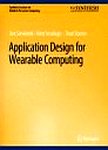版权所有:内蒙古大学图书馆 技术提供:维普资讯• 智图
内蒙古自治区呼和浩特市赛罕区大学西街235号 邮编: 010021

丛 书 名:Synthesis Lectures on Mobile & Pervasive Computing
版本说明:1
I S B N:(纸本) 9783031013485
出 版 社:Springer Cham
出 版 年:1000年
页 数:VI, 70页
主 题 词:Mathematics, general Engineering, general Mobile Computing Cyber-physical systems, IoT User Interfaces and Human Computer Interaction
摘 要:The confluence of decades of computer science and computer engineering research in multimodal interaction (e.g., speech and gesture recognition), machine learning (e.g., classification and feature extraction), software (e.g., web browsers, distributed agents), electronics (e.g., energy-efficient microprocessors, head-mounted displays), design methodology in user-centered design, and rapid prototyping have enabled a new class of computers—wearable computers. The lecture takes the viewpoint of a potential designer or researcher in wearable computing. Designing wearable computers requires attention to many different factors because of the computer’s closeness to the body and its use while performing other tasks. For the purposes of discussion, we have created the UCAMP framework, which consists of the following factors: user, corporal, attention, manipulation, and perception. Each of these factors and their importance is described. A number of example prototypes developed by the authors,as well as by other researchers, are used to illustrate these concepts. Wearable computers have established their first foothold in several application domains, such as vehicle and aircraft maintenance and manufacturing, inspection, language translation, and other areas. The lecture continues by describing the next step in the evolution of wearable computers, namely, context awareness. Context-aware computing takes into account a user’s state and surroundings, and the mobile computer modifies its behavior based on this information. A user’s context can be quite rich, consisting of attributes such as physical location, physiological state, personal history, daily behavioral patterns, and so forth. If a human assistant were given such context, he or she would make decisions in a proactive fashion, anticipating user needs, and acting as a proactive assistant. The goal is to enable mobile computers to play an analogous role, exploiting context information to significantly reduce demands onh